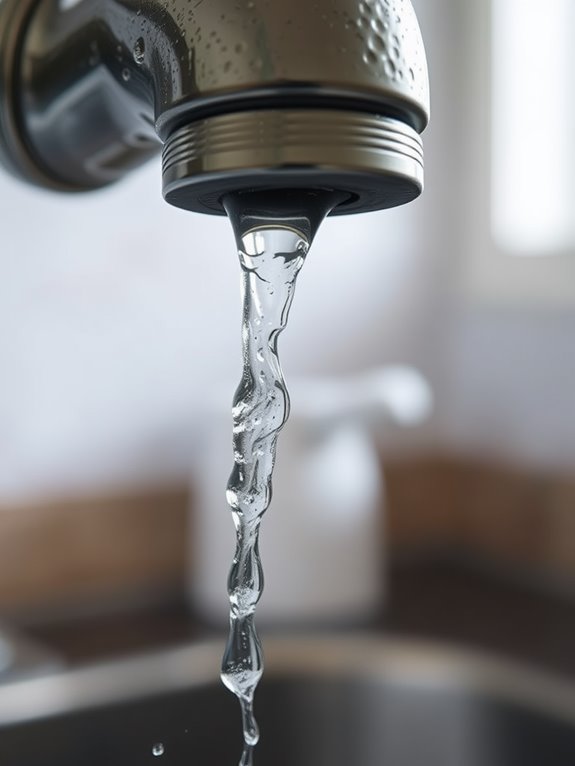A whole house water filter can reduce water pressure if it’s undersized or clogged. When filters are well-sized and regularly maintained, they shouldn’t restrict flow. Check for clogs, inspect the main shut-off valve, and clean faucet aerators to boost pressure. If you notice persistent low pressure, even after troubleshooting, it might signal a deeper issue. There’s more to uncover about factors affecting water pressure and what you can do to enhance your water system’s performance.
Understanding Whole House Water Filters and Water Pressure

When you consider a whole house water filter, it’s vital to understand how it interacts with your home’s water pressure.
These systems work by filtering the water before it reaches your faucets, which can sometimes lead to a drop in pressure. The filter’s design and size impact this interaction markedly.
A well-sized filter won’t restrict flow, while an undersized one might cause noticeable pressure loss. Additionally, clogged filters can further reduce pressure, so regular maintenance is necessary.
Knowing how your filter functions helps you anticipate any changes in water pressure and guarantees a consistent supply throughout your home.
Factors That Affect Water Pressure in Your Home
Water pressure in your home can be influenced by several key factors that homeowners should be aware of.
First, the size of your pipes plays a significant role; smaller pipes can restrict flow.
Next, the condition of your plumbing is vital; rust or mineral buildup can hamper water movement.
Additionally, the municipal water supply pressure impacts your home’s pressure levels; fluctuations from local sources can create inconsistencies.
Finally, the layout of your plumbing system, including bends and turns, can affect pressure.
Keeping these factors in mind can help you troubleshoot and maintain ideal water pressure in your home.
Here’s another post you might find useful: Best Hard Water Shower Filters: Protect Your Skin and Hair
Signs That Your Water Pressure Is Being Affected

If you’ve noticed a drop in your shower’s intensity or your kitchen faucet seems to take longer to fill, it’s likely that your water pressure is being affected.
Other signs include weak flow from multiple fixtures simultaneously, which can make tasks like washing dishes frustrating. You might also hear unusual noises, such as banging or whistling, in your pipes when you turn on the water.
Additionally, if you’re struggling with filling your washing machine or garden hose, it’s another indication.
Keeping an eye on these signs can help you identify potential issues with your water system early on.
Don’t miss out on related tips: Read this next: can a PVC pipe be used for potable water?
Troubleshooting Tips for Low Water Pressure
Noticing those signs of low water pressure can be frustrating, but there are several troubleshooting tips you can try to restore flow. Start by checking for leaks around your faucets and pipes. Next, clean or replace your faucet aerators and showerheads to remove mineral buildup. Don’t forget to verify your main shut-off valve is fully open. Also, inspect your water filter for clogs. Here’s a quick reference table:
| Tip | Action | Result |
|---|---|---|
| Check for leaks | Inspect faucets and pipes | Identifies problem areas |
| Clean aerators | Remove and rinse | Improves water flow |
| Open shut-off valve | Turn valve fully | Increases pressure |
| Inspect water filter | Check for clogs | verifies proper filtration |
| Flush the system | Run water for a few minutes | Clears any blockages |
When to Consider Professional Help for Water Pressure Issues

While many low water pressure issues can be resolved with a few simple fixes, there are times when calling in a professional becomes necessary.
If you notice persistent low pressure despite troubleshooting, don’t hesitate to seek help.
Here are three situations where professional assistance is essential:
- Complex plumbing issues: If you suspect leaks in hidden pipes or complicated plumbing setups.
- Water quality concerns: When low pressure accompanies discolored or foul-smelling water.
- Frequent clogs: If you experience recurring clogs in multiple fixtures, indicating deeper system problems.
A professional can diagnose and resolve these issues effectively.
Conclusion
To sum up, a whole house water filter can sometimes cause a dip in water pressure, but it’s often just a bump in the road. By understanding the factors at play and keeping an eye out for signs of trouble, you can troubleshoot effectively. If things get too tricky, don’t hesitate to call in a professional. Remember, when it rains, it pours, but with the right steps, you can keep your water flow steady and strong!

I’m Allen Kim, the chief editor of plumbinginto. I am a mid level plumber and assign to an local firm over 4 years of experience. During the working period, most of my experience is related to the house plumbing. I learned about the thing, when working with most experienced people in this sector, one must be as good as the inspector or better with knowledge of the project as well as the practical aspects of plumbing industry.